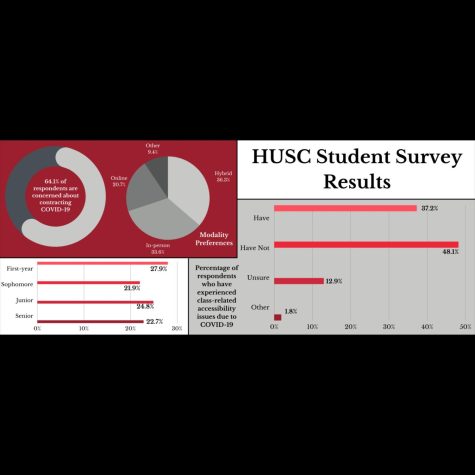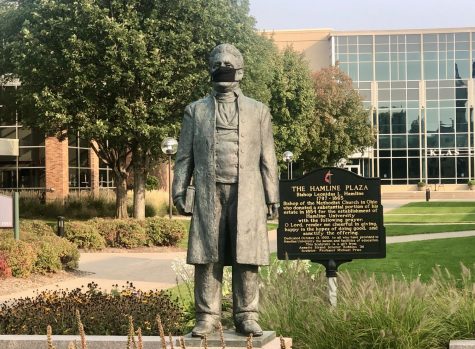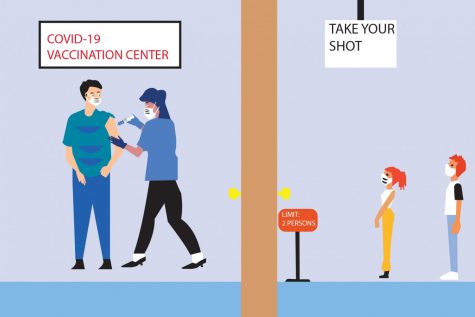COVID-19 changes spark apprehension
Hamline is experiencing confusion as it maneuvers the newest phase of the COVID-19 pandemic: being vaccinated.
October 27, 2021
Hamline is still in the grips of COVID-19, like greater St. Paul and the nation.
The difference this year versus last is the COVID-19 vaccine. With about 94% of undergraduate students and 98.5% of staff and faculty fully vaccinated, Hamline navigates a new phase of the fight against COVID-19.
This new step in the COVID-19 battle has resulted in some confusion. Students have faced mixed feelings and uncertainty about the changes to quarantine procedures.
For those fully vaccinated, if they are determined to be in close contact to someone who has tested positive for COVID-19, they do not have to quarantine. They should wear their mask at all times, including in their own homes and dorms if they are in the presence of others and be conscious of the need for physical distancing in places of housing and dining.
At the five to seven-day mark, the COVID-19 Response team will help coordinate a COVID-19 test. It is not until this time that the infection generally begins to show in the body. If this test is negative, the person is set to go. If it comes back positive, they would enter isolation.
The amount of time someone can be in isolation varies, with ten days from their point of contact being the general situation. Isolation time is determined on a case-by-case basis.
Quarantine is for close contact situations and possibly someone with mild symptoms. This is different from isolation, where a positive case is confirmed for the individual.
“We will continue to monitor things and see what the impact is and we’re also seeking out guidance from public health and medical professionals, to make sure that we’re making the best decisions,” COVID Coordinator Melinda Heikkinen said. “We’re very aware of the impact of these decisions on the student experience so that is a big part of the conversation, but our priority has to be your safety.”
Hamline continues to follow recommendations from the CDC and the MN Department of Health (MNDH). Some students still feel hesitant with the new quarantining requirements.
Senior Will Deery who is fully vaccinated was exposed for more than 15 minutes to a fully vaccinated, but positive COVID-19 case. He went through the steps to inform Hamline about the situation, and they emailed him back within a matter of hours.
“They told me that, ‘It is likely because you were both masked that no exposure took place. As a vaccinated student, there’s no requirement for you to quarantine.’ I immediately saw that and I went, ‘that doesn’t seem safe,’ because we know about the strain that can infect vaccinated people, and knowing that there is no requirement for vaccine students to have to quarantine is a little bit scary to me,” Deery said. “The only thing they told me is that I didn’t have to quarantine and that to be tested on or after the day five after the possible exposure. That and to watch out for symptoms.”
The world continues to combat the Delta variant which poses uncharted difficulties. Some were looking forward to different mitigation strategies such as unmasking with the vaccine, but that is not recommended from the CDC.
“Unfortunately the Delta variant really threw a wrench into that, because we, the entire state of Minnesota per CDC information, is at a high transmission rate and CDC guidance for transmission rates for that is to wear masks indoors,” Heikkinen said.
Another misconception Heikkinen has heard is regarding the possibility of getting sick after being vaccinated.
“People think ‘I’m fully vaccinated, I can’t get COVID.’ Unfortunately because of the Delta variant, you can get COVID. The thing is you’re very unlikely to get severely ill. You may not even know that you have it,” Heikkinen said.
To combat this, someone vaccinated should get tested at that five to seven-day mark in order to move forward safest.
The other common misconception is about the lack of masking in stores and locations off-campus and why the community still has to be masked on-campus.
“I know it’s really difficult when you go out in the world… and nobody’s wearing masks and nobody’s saying anything to them so I think there’s some confusion of, ‘it’s not happening out there, why does it happen on campus,’” Heikkinen said. “It should be happening out there, that’s why it’s happening on campus. A lot of these organizations and stores…if you really look, there are signs that recommend you wear masks while you’re inside.”
Another factor that has returned from last year is the use of seating charts for contact tracing. Seating charts play a larger role this academic year since students are now 3 feet apart, a recommendation from the MNDH. This change in distance has allowed for more in-person classes.
Though the amount of distance in a class has changed, the definition of close contact has not. Close contact is described as spending more than a cumulative 15 minutes being less than six feet near someone with a positive case masked or unmasked. However, there have been no classroom transmissions at Hamline as of publishing.
As we near Halloween, Heikkinen is reminded of the spike that was seen in positive cases at Hamline last year after this time.
“I know it’s Halloween you want to go out, you want to have a good time but be safe about it, if you’re in a group of people wear a mask,” Heikkinen said. “If you’re outdoors, and you’re in a great big group of people put on a mask. It is the best way to reduce your chances of getting COVID whether you’re vaccinated or not. If you’re not vaccinated, consider something much smaller… For the well being of the whole campus and for your own safety and well being, please please please please please wear masks.”




